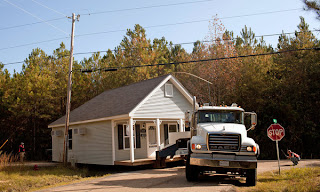Last week's New York Times had a very interesting article under the Home section.
In recent years, cash-strapped Americans are buying land and then bringing in inexpensive or even free houses that would have otherwise been torn down. Many of these houses come from used-house lots, where one can choose from a wide range of styles.  Warren Davie, the owner of Davie Shoring, a structural mover with a used-house lot outside of New Orleans, said his business increased 50 percent since 2008. Mr. Davie said most buyers are "hard-working people who don't want to go into debt to own a home and are willing to put a little sweat equity into the project".
Warren Davie, the owner of Davie Shoring, a structural mover with a used-house lot outside of New Orleans, said his business increased 50 percent since 2008. Mr. Davie said most buyers are "hard-working people who don't want to go into debt to own a home and are willing to put a little sweat equity into the project".
 Warren Davie, the owner of Davie Shoring, a structural mover with a used-house lot outside of New Orleans, said his business increased 50 percent since 2008. Mr. Davie said most buyers are "hard-working people who don't want to go into debt to own a home and are willing to put a little sweat equity into the project".
Warren Davie, the owner of Davie Shoring, a structural mover with a used-house lot outside of New Orleans, said his business increased 50 percent since 2008. Mr. Davie said most buyers are "hard-working people who don't want to go into debt to own a home and are willing to put a little sweat equity into the project".Depending on a home's size, its condition and how far it has to be moved, the cost can range from $15,000 to $60,000. That's about 40 to 60 percent of what it would cost to build the same structure from scratch.
Moving a house is, in theory, relatively simple. If it is on a pier-and-beam foundation, structural movers slide steel beams under the ground floor to lift it; if the house is on a concrete slab, the mover uses jackhammer to create tunnels where support beams can be inserted. Then the house is raised on jacks, dollies are maneuvered beneath it, and the beams supporting the house are lowered onto the dollies, which have an integrated hydraulic suspension system that adjusts to the road, so that no part of the house is unduly stressed on the way.
Once the building arrives at its new location, it is lowered into place, using jacks, and allowed to settle into its new neighborhood. All of which is exciting to watch, for homeowner and mover alike!
Source: New York Times, November 17, 2011







